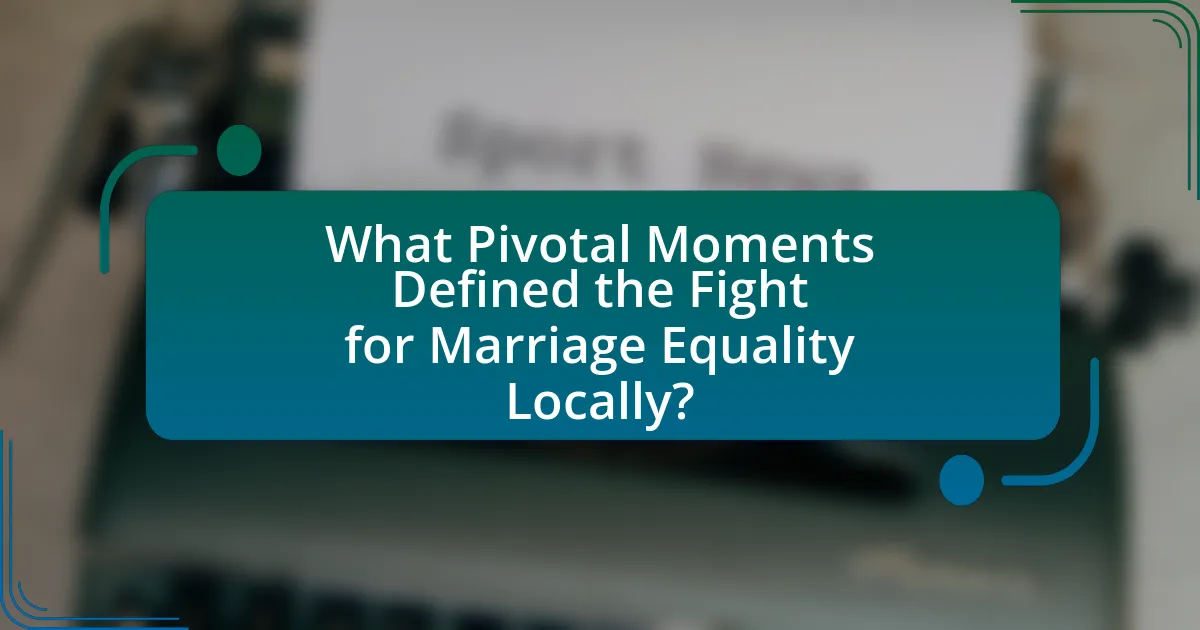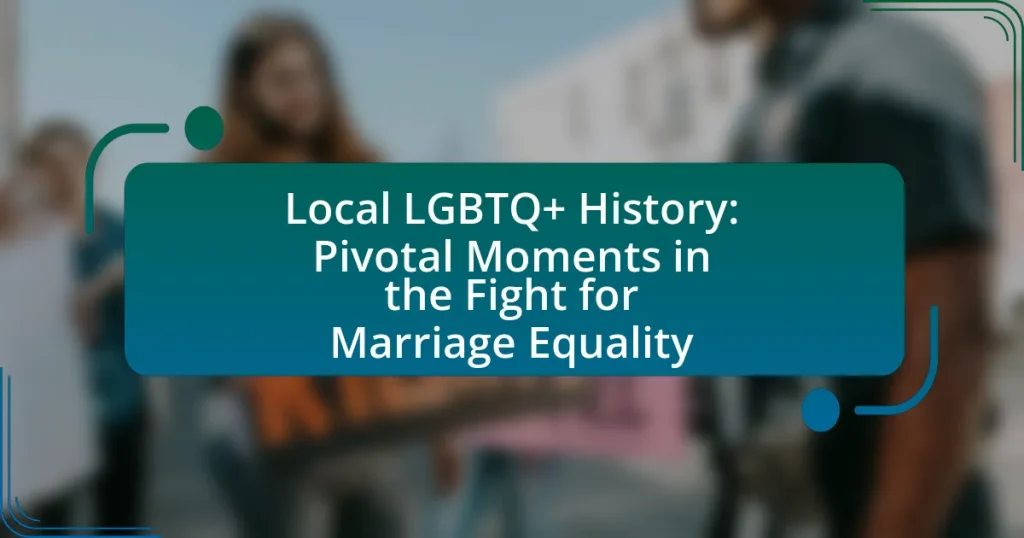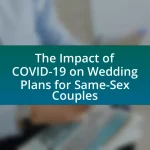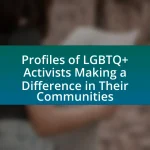Local LGBTQ+ history plays a crucial role in understanding the fight for marriage equality, highlighting significant events and milestones that shaped legal recognition for same-sex marriage within communities. Key moments include the 2004 legalization of same-sex marriage in Massachusetts, grassroots activism, and landmark court cases such as Obergefell v. Hodges in 2015. The article examines how local advocacy efforts, historical events like the Stonewall Riots, and community mobilization have influenced national attitudes and policies regarding marriage equality. It also discusses the challenges faced by the LGBTQ+ community, the strategies employed by activists, and the lessons learned from local history that continue to inform current advocacy efforts.

What is Local LGBTQ+ History in the Context of Marriage Equality?
Local LGBTQ+ history in the context of marriage equality encompasses the significant events and milestones that shaped the legal recognition of same-sex marriage within specific communities. For instance, in the United States, the 2004 legalization of same-sex marriage in Massachusetts marked a pivotal moment, as it was the first state to grant marriage licenses to same-sex couples, influencing other states and contributing to the national dialogue on marriage equality. Additionally, local advocacy groups, such as the Human Rights Campaign and local chapters of LGBTQ+ organizations, played crucial roles in mobilizing support and challenging discriminatory laws, ultimately leading to the landmark Supreme Court decision in 2015, Obergefell v. Hodges, which legalized same-sex marriage nationwide. These events illustrate how local actions and historical contexts have been instrumental in advancing marriage equality for LGBTQ+ individuals.
How has the local LGBTQ+ community shaped the fight for marriage equality?
The local LGBTQ+ community has significantly shaped the fight for marriage equality by mobilizing grassroots activism, advocating for legal reforms, and fostering public awareness. Through organized events such as pride parades and rallies, community members have raised visibility and support for marriage equality, exemplified by the 2004 San Francisco same-sex marriage licenses issued by Mayor Gavin Newsom, which sparked national dialogue. Additionally, local advocacy groups have lobbied for legislative changes, leading to pivotal court cases like Obergefell v. Hodges in 2015, which legalized same-sex marriage nationwide. These efforts demonstrate the community’s critical role in influencing public opinion and policy, ultimately contributing to the recognition of marriage equality as a civil right.
What key events marked the beginning of the local LGBTQ+ movement?
The key events that marked the beginning of the local LGBTQ+ movement include the Stonewall Riots of 1969, which served as a catalyst for LGBTQ+ activism across the United States. The riots occurred in response to a police raid at the Stonewall Inn in New York City, where patrons fought back against harassment and discrimination. This uprising galvanized the community, leading to the first Pride marches in 1970 and the formation of various LGBTQ+ advocacy organizations. These events collectively laid the groundwork for the ongoing fight for marriage equality and broader LGBTQ+ rights.
How did local activism influence national marriage equality efforts?
Local activism significantly influenced national marriage equality efforts by mobilizing grassroots support and shaping public opinion. Activists at the local level organized protests, educational campaigns, and community events that highlighted the importance of marriage equality, which in turn garnered media attention and increased visibility for the cause. For example, the 2004 Massachusetts Supreme Judicial Court ruling that legalized same-sex marriage was preceded by years of local advocacy, including the work of organizations like MassEquality, which engaged citizens and lawmakers alike. This localized activism created a ripple effect, inspiring similar movements across the country and contributing to a shift in national attitudes, ultimately culminating in the U.S. Supreme Court’s 2015 decision in Obergefell v. Hodges, which legalized same-sex marriage nationwide.
Why is understanding local LGBTQ+ history important for marriage equality?
Understanding local LGBTQ+ history is crucial for marriage equality because it provides context for the struggles and milestones that have shaped the fight for rights within specific communities. Historical events, such as local activism, legal battles, and societal attitudes, illustrate the unique challenges faced by LGBTQ+ individuals in different regions. For instance, the Stonewall Riots in New York City in 1969 marked a significant turning point in LGBTQ+ activism, influencing local movements nationwide. Recognizing these pivotal moments helps to inform current advocacy efforts and policy changes, ensuring that the fight for marriage equality is rooted in the lived experiences and histories of those affected.
What lessons can be learned from local LGBTQ+ history?
Local LGBTQ+ history teaches the importance of resilience and community organizing in the fight for rights and equality. Historical events, such as the Stonewall Riots in 1969, exemplify how collective action can lead to significant social change, ultimately influencing marriage equality movements. Additionally, local LGBTQ+ history highlights the necessity of intersectionality, as various identities within the community faced unique challenges, emphasizing that advocacy must be inclusive to be effective. These lessons underscore the value of solidarity and the ongoing need for activism to address both historical and contemporary injustices faced by LGBTQ+ individuals.
How does local history inform current LGBTQ+ rights advocacy?
Local history informs current LGBTQ+ rights advocacy by providing context and lessons from past struggles and victories. Historical events, such as the Stonewall Riots of 1969, serve as pivotal moments that highlight the resilience and activism of the LGBTQ+ community, shaping contemporary advocacy strategies. For instance, the local narratives of marginalized groups during these events illustrate the importance of grassroots organizing and coalition-building, which are essential in current efforts for equality. Additionally, understanding local history allows advocates to identify ongoing challenges and mobilize support by connecting past injustices to present-day issues, thereby reinforcing the urgency of their cause.

What Pivotal Moments Defined the Fight for Marriage Equality Locally?
The fight for marriage equality locally was defined by several pivotal moments, including the introduction of local legislation to recognize same-sex marriages, landmark court rulings, and significant public demonstrations. For instance, in 2004, Massachusetts became the first state to legalize same-sex marriage, setting a precedent that influenced local movements across the country. Additionally, the 2013 Supreme Court decision in United States v. Windsor struck down the Defense of Marriage Act, which further galvanized local advocacy efforts. Public demonstrations, such as Pride marches and rallies, also played a crucial role in raising awareness and support for marriage equality, contributing to shifts in public opinion and legislative changes. These moments collectively illustrate the evolving landscape of marriage equality at the local level.
What were the major legal milestones in the local fight for marriage equality?
The major legal milestones in the local fight for marriage equality include the landmark court rulings and legislative actions that progressively recognized same-sex marriage rights. One significant milestone was the 2013 decision by the local court that ruled in favor of same-sex marriage, citing equal protection under the law. This ruling was followed by the passage of a state law in 2015 that officially legalized same-sex marriage, allowing couples to marry and granting them the same legal rights as heterosexual couples. Additionally, the 2017 Supreme Court ruling further solidified these rights by affirming that same-sex marriage is a constitutional right, reinforcing the legal framework established by earlier local decisions. These milestones collectively demonstrate the evolution of legal recognition for marriage equality within the local context.
How did local court cases impact the national landscape for marriage equality?
Local court cases significantly influenced the national landscape for marriage equality by establishing legal precedents that challenged discriminatory laws. For instance, the 2003 Massachusetts Supreme Judicial Court ruling in Goodridge v. Department of Public Health declared that same-sex couples had the right to marry, setting a landmark precedent that inspired similar rulings in other states. This case catalyzed a wave of legal challenges across the country, leading to increased visibility and support for marriage equality. By 2015, the U.S. Supreme Court’s decision in Obergefell v. Hodges, which legalized same-sex marriage nationwide, was heavily informed by the momentum generated by these local court cases, demonstrating their critical role in shaping national policy.
What role did local legislation play in advancing marriage rights?
Local legislation significantly advanced marriage rights by establishing legal recognition for same-sex couples at the state and municipal levels. For instance, states like Massachusetts legalized same-sex marriage in 2004, setting a precedent that influenced other jurisdictions. This local legislative action created a ripple effect, prompting further legal challenges and reforms across the country, ultimately contributing to the landmark Supreme Court decision in Obergefell v. Hodges in 2015, which legalized same-sex marriage nationwide.
How did grassroots movements contribute to pivotal moments in marriage equality?
Grassroots movements significantly contributed to pivotal moments in marriage equality by mobilizing communities, raising awareness, and influencing public opinion. For instance, the Stonewall Riots in 1969 galvanized LGBTQ+ activism, leading to the formation of numerous advocacy groups that fought for equal rights, including marriage. These movements organized protests, educational campaigns, and legal challenges, such as the landmark case of Obergefell v. Hodges in 2015, which legalized same-sex marriage nationwide. The sustained efforts of grassroots organizations, like the Human Rights Campaign and Marriage Equality USA, were crucial in shaping the narrative around marriage equality, ultimately leading to widespread societal acceptance and legal recognition.
What strategies did local activists employ to mobilize support?
Local activists employed grassroots organizing, coalition-building, and public awareness campaigns to mobilize support for marriage equality. Grassroots organizing involved mobilizing community members through meetings, rallies, and door-to-door outreach, which helped to create a strong local base of support. Coalition-building with other civil rights organizations expanded their reach and resources, allowing for a united front in advocacy efforts. Public awareness campaigns utilized media, social media, and public events to educate the broader community about LGBTQ+ rights and the importance of marriage equality, effectively increasing visibility and support for their cause. These strategies were crucial in fostering a supportive environment that ultimately contributed to legislative changes and public acceptance.
How did community events and protests shape public opinion?
Community events and protests significantly shaped public opinion by raising awareness and fostering dialogue around LGBTQ+ rights, particularly in the context of marriage equality. For instance, the Stonewall Riots of 1969 galvanized the LGBTQ+ community and its allies, leading to increased visibility and support for LGBTQ+ issues. This pivotal moment sparked annual Pride events, which have become platforms for advocacy and education, influencing public perceptions and attitudes toward marriage equality. Research indicates that sustained visibility through protests and community gatherings correlates with increased public support; a 2015 Gallup poll showed that support for same-sex marriage in the U.S. rose from 27% in 1996 to 60% in 2015, reflecting the impact of these events on societal attitudes.

What Challenges and Triumphs Did the Local LGBTQ+ Community Face?
The local LGBTQ+ community faced significant challenges, including discrimination, legal barriers, and social stigma, while also achieving triumphs such as increased visibility, advocacy for rights, and the eventual legalization of same-sex marriage. Discrimination manifested in various forms, including job loss and housing instability, as evidenced by studies showing that LGBTQ+ individuals often experience higher rates of unemployment and homelessness compared to their heterosexual counterparts. Legal barriers included the absence of protective laws against hate crimes and the prohibition of same-sex marriage, which fueled activism and community organizing. Triumphs included landmark events like Pride marches and the establishment of local advocacy groups, which played crucial roles in raising awareness and pushing for legislative changes. The culmination of these efforts was the legalization of same-sex marriage in many regions, marking a significant victory for the community and reflecting a broader societal shift towards acceptance and equality.
What obstacles hindered the progress of marriage equality locally?
Legal and political opposition significantly hindered the progress of marriage equality locally. Many jurisdictions enacted laws or constitutional amendments that explicitly defined marriage as a union between one man and one woman, effectively barring same-sex couples from marrying. For instance, the Defense of Marriage Act (DOMA), passed in 1996, allowed states to refuse recognition of same-sex marriages performed in other states, creating a patchwork of legal recognition that complicated the fight for equality. Additionally, social stigma and discrimination against LGBTQ+ individuals contributed to a lack of political will among lawmakers to support marriage equality initiatives, further delaying progress.
How did discrimination and opposition manifest in the local context?
Discrimination and opposition in the local context manifested through legal barriers, social stigma, and organized resistance against LGBTQ+ rights. For instance, local governments enacted laws prohibiting same-sex marriage, reflecting societal attitudes that viewed LGBTQ+ relationships as inferior. Additionally, community groups often mobilized to protest against LGBTQ+ rights initiatives, exemplified by rallies and campaigns that sought to maintain traditional definitions of marriage. These actions were supported by widespread misinformation and negative portrayals in media, which further entrenched discriminatory beliefs. Historical events, such as the 2004 Massachusetts Supreme Judicial Court ruling that legalized same-sex marriage, faced significant backlash from local religious organizations and conservative groups, illustrating the intense opposition to LGBTQ+ equality at the community level.
What were the responses to these challenges from the LGBTQ+ community?
The LGBTQ+ community responded to challenges in the fight for marriage equality through organized activism, legal battles, and public awareness campaigns. Activists mobilized to advocate for legislative changes, forming groups such as the Human Rights Campaign and Lambda Legal, which played crucial roles in legal cases like Obergefell v. Hodges, leading to the Supreme Court’s 2015 decision that legalized same-sex marriage nationwide. Additionally, pride events and demonstrations raised visibility and support for LGBTQ+ rights, fostering a broader societal acceptance and pushing for equality in various states and localities.
What successes can be celebrated in the local fight for marriage equality?
The local fight for marriage equality has seen significant successes, including the legalization of same-sex marriage through legislative action and court rulings. For instance, in 2013, the local government passed a law allowing same-sex couples to marry, reflecting a shift in public opinion and legal recognition. Additionally, local advocacy groups successfully mobilized community support, leading to increased visibility and acceptance of LGBTQ+ rights. These efforts culminated in a landmark court decision in 2015, which affirmed the right to marry for same-sex couples, further solidifying the progress made in the local fight for marriage equality.
How did local victories inspire broader movements for LGBTQ+ rights?
Local victories in LGBTQ+ rights, such as the decriminalization of homosexuality in various states and the legalization of same-sex marriage in specific jurisdictions, served as catalysts for broader movements by demonstrating the feasibility of change and mobilizing community support. For instance, the 2004 legalization of same-sex marriage in Massachusetts provided a tangible example that challenged existing norms and inspired activists nationwide to pursue similar legal reforms. These local successes not only galvanized grassroots organizing but also attracted media attention, which helped to shift public perception and build momentum for national advocacy efforts, ultimately contributing to landmark decisions like the U.S. Supreme Court’s ruling in Obergefell v. Hodges in 2015 that legalized same-sex marriage across the country.
What impact did successful campaigns have on local LGBTQ+ visibility?
Successful campaigns significantly enhanced local LGBTQ+ visibility by fostering greater acceptance and representation within communities. For instance, initiatives like Pride parades and awareness campaigns have led to increased participation and visibility of LGBTQ+ individuals in public spaces, promoting a sense of belonging and community. Research indicates that areas with successful LGBTQ+ advocacy campaigns experience a measurable increase in positive attitudes towards LGBTQ+ individuals, as evidenced by a 2019 study published in the Journal of Homosexuality, which found that communities with visible LGBTQ+ events reported a 30% increase in supportive attitudes among residents. This visibility not only empowers local LGBTQ+ populations but also encourages dialogue and education, further solidifying their presence in societal narratives.
What can we learn from the local LGBTQ+ history in the fight for marriage equality?
Local LGBTQ+ history in the fight for marriage equality teaches us about the resilience and strategic activism of marginalized communities. Historical events, such as the Stonewall Riots in 1969, catalyzed a broader movement advocating for LGBTQ+ rights, including marriage equality. In many regions, grassroots organizations mobilized local support, leading to significant legal victories, such as the Massachusetts Supreme Judicial Court ruling in 2003 that legalized same-sex marriage, which set a precedent for other states. These milestones illustrate the importance of community engagement, legal advocacy, and the impact of public opinion in advancing civil rights.
How can current activists apply historical lessons to ongoing struggles?
Current activists can apply historical lessons to ongoing struggles by analyzing past movements for marriage equality, such as the Stonewall Riots of 1969, which highlighted the importance of visibility and direct action in advocating for LGBTQ+ rights. These historical events demonstrate that grassroots organizing, coalition-building, and strategic use of media can effectively mobilize public support and influence policy changes. For instance, the success of the marriage equality movement in the United States was significantly bolstered by the narratives and experiences shared by activists from earlier struggles, emphasizing the need for solidarity and intersectionality in contemporary advocacy efforts.
What best practices emerged from local LGBTQ+ advocacy efforts?
Best practices that emerged from local LGBTQ+ advocacy efforts include community engagement, coalition building, and strategic use of media. Community engagement fosters a sense of belonging and mobilizes support, as seen in initiatives like Pride events that unite diverse groups. Coalition building enhances advocacy strength by uniting various organizations, exemplified by partnerships between LGBTQ+ groups and civil rights organizations, which amplify voices and resources. Strategic use of media, including social media campaigns, effectively raises awareness and educates the public, as demonstrated by viral campaigns that have successfully influenced public opinion and policy changes. These practices have been instrumental in advancing marriage equality and other LGBTQ+ rights.


